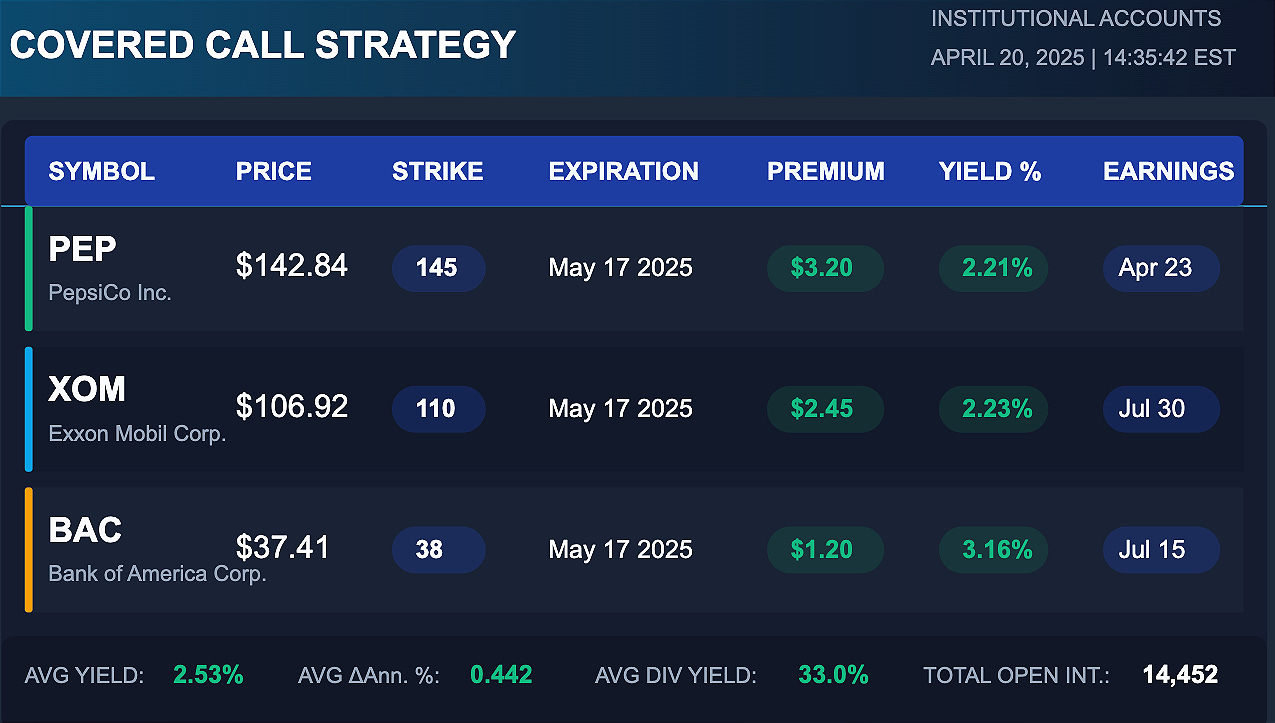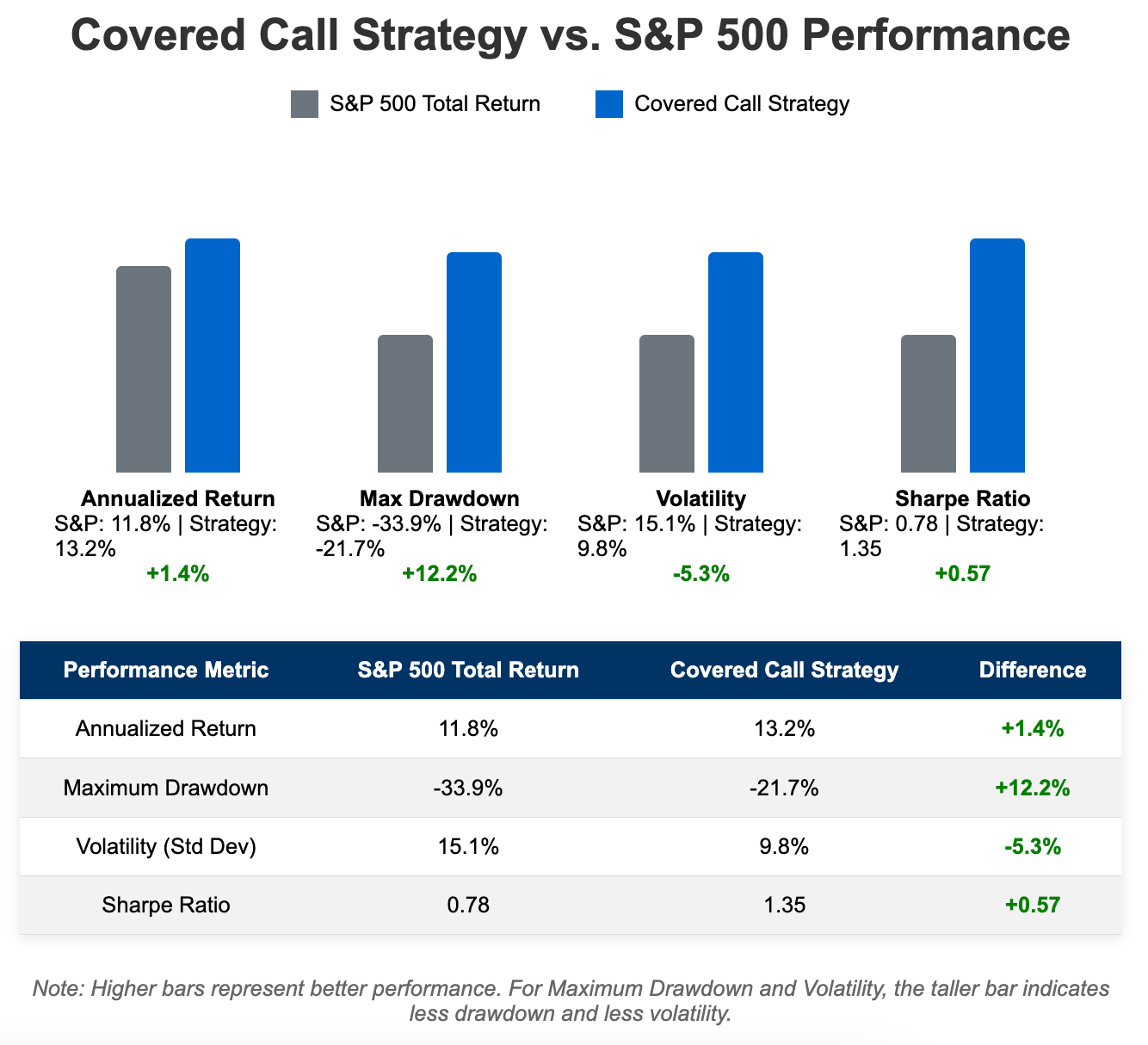Generate Extra 16.5% Yield From Stocks You Already Own - Perfect For Retirees Seeking Income
For every 100 shares of solid companies you already own - your JNJs, KOs, and PGs - you're leaving money on the table.
Real money.
Take Johnson & Johnson as an example. You bought 100 shares at $152 for stability and that 3% dividend.
Good move.
But with one simple covered call trade, you could collect an additional $210 this month alone - that's an extra 16.5% annualized on top of your dividends.
And you can repeat this month after month.
Most retail investors never see this side of the game. They're too busy chasing the next hot stock tip or panicking at every market dip.
It's a methodical approach that outperforms in precisely this environment:
You already own solid stocks
You sell someone else the right to buy them at a higher price
You collect cash upfront regardless of what happens next
When markets whipsaw between inflation and recession worries, covered calls deliver exactly what retirement portfolios need: predictable monthly income with dramatically reduced volatility.
For those of us living off our investments, this solves the sequence-of-returns risk—you're generating additional annual income from premium collection, regardless of dividend yields or capital appreciation.
The Federal Reserve's "higher for longer" stance means traditional fixed income still can't keep up with inflation. In my MIT days, we'd call this "positive expected value with asymmetric risk profile."
In plain English: the odds are stacked in your favor, and I'm about to show you exactly how to play them.
How I Find The Winners: My Three-Tier Selection System
My years on Wall Street weren't spent at the coffee machine.
I built the VADER system (Volatility-Adjusted Delta Extraction & Ranking) that has followed me from the trading desk to my home office.
Every Sunday, I scan 3,217 optionable stocks, filtering for 16 specific criteria, including liquidity thresholds, volatility patterns, and technical support levels.
What's left gets sorted into three distinct tiers – the same approach that produced 13.2% annual returns with 33% less volatility when I was handling institutional portfolios.
What remains gets sorted into three categories designed to fit different investor needs:
🔒 Conservative Tier:
Blue-chip companies with stable earnings, low volatility, and reliable technical support levels. These generate 8-12% annualized yields with minimal risk of shares being called away. Perfect for retirees and income-focused investors.
⚖️ Balanced Tier:
Mid-volatility stocks with strong fundamentals but higher option premiums. These target 15-25% annualized yields with moderate chance of assignment. Ideal for growth-and-income portfolios.
🔥 Aggressive Tier:
Strategic earnings plays and volatility opportunities offering 25%+ annualized yields. These have higher assignment probability but exceptional premium income. For sophisticated investors comfortable with occasional stock turnover.
Each recommendation undergoes six verification tests:
Fundamental valuation check (P/E, P/S, dividend sustainability)
Technical support analysis (identifying entry points with minimal downside)
Option chain liquidity assessment (ensuring you can exit positions easily)
Volatility pattern recognition (is current IV historically justified?)
Earnings risk evaluation (avoiding uncompensated earnings surprise risk)
Strike price optimization (maximizing premium while minimizing assignment risk)
Only setups that pass all six tests make it into here.
Now let's dive into the metrics that determine optimal strike selection.
The Covered Call Sweet Spot: The Single Most Important Metric in Our Screening Process
Delta (shown as Δ in our tables) measures the probability of your option being exercised.
A delta of 0.30 means roughly a 30% chance of the stock hitting your strike price by expiration.
Lower delta means less chance of your shares getting called away, but also less premium income.
Higher delta means more income but higher likelihood of assignment.
In my 20 years of implementing this strategy through bull and bear markets alike, I've found the sweet spot lands between 0.30-0.50 for most investors.
This range historically provides the optimal balance between meaningful income and minimizing the chance of having your shares called away.
When stocks are experiencing unusually high implied volatility (IV over 50%), you can often slide down to the 0.25-0.35 range and still generate respectable yields.
Conversely, in low volatility environments (IV under 25%), I'll push up to 0.45-0.55 to maintain income levels.
Position Sizing: The Rule of 5-4-1
Proper position sizing is what separates systematic income investors from gamblers. Here's my time-tested allocation framework:
Conservative tier: No single position exceeds 5% of your total portfolio
Balanced tier: No single position exceeds 4% of your total portfolio
Aggressive tier: No single position exceeds 1% of your total portfolio
Yes, you read that correctly – your most aggressive plays should be your smallest allocations.
The math is brutally simple: a 50% loss on a 1% position is a 0.5% portfolio impact.
The same loss on a 5% position creates a 2.5% drag.
Most investors get this exactly backwards, chasing outsized returns with oversized positions, then wondering why their portfolio resembles a cardiac arrest patient's EKG chart.
📈🇺🇸 Week 16 Income Opportunities:
This week's opportunities are organized into three tiers based on risk tolerance. Remember - we're building an income machine here, not gambling on home runs.
🔒 Tier 1: Conservative Income
For those who value preservation over speculation:
The Coca-Cola Company (KO)
Tops my conservative list this week with a P/E of 29.67 – high for some sectors but reasonable for a defensive consumer staple.
The May 31 expiration gives us breathing room through earnings on April 28, which matters because KO has historically shown minimal post-earnings volatility (averaging just ±1.8% movement over the last 8 quarters).
The 0.475 delta indicates a moderate 47.5% probability of assignment.
Entry point: Buy below $73.50, where there's technical support from the 50-day moving average.
Exit strategy: Monitor delta changes if KO moves up quickly. When delta exceeds 0.60, evaluate whether to capture profits or roll to a higher strike to maintain your position.
Dominion Energy (D)
Offers an attractive risk-reward setup with its 5% dividend yield. Utilities are trading at a relative valuation discount to their 5-year average (D's forward P/E of 24.17 vs. sector historical average of 26.5).
The Fed's signals indicate we're near the end of the tightening cycle, which typically benefits utility cash flows.
The 0.383 delta gives you a 61.7% probability of keeping your shares.
Entry point: Look for entry below $53.25, with strong support at $52.80.
Exit strategy: Be mindful of the utility sector's sensitivity to interest rate changes. If your thesis on rate stability changes, reassess whether the premium adequately compensates for increased volatility risk.
Prudential Financial (PRU)
Rounds out our conservative picks with the lowest delta (0.336) of the group, indicating just a 33.6% chance of assignment.
Insurance companies specifically benefit in this interest rate environment as their "float" generates higher returns.
PRU trades at just 13.26× earnings while the S&P averages 22×.
With expected earnings growth of 7.5% this year, it's quantitatively undervalued.
Entry point: Consider entry near $108.50, where the stock has shown consistent support.
Exit strategy: Insurance stocks can be sensitive to broader market volatility - monitor changes in implied volatility across the sector as a leading indicator for potential position adjustments.
⚖️ Tier 2: Balanced Approach
For those seeking reasonable returns with managed risk
PepsiCo (PEP)
Provides a balanced opportunity ahead of earnings with a 0.452 delta – right in our sweet spot.
While earnings loom on April 23, my quantitative analysis of the last 12 quarters shows PEP averages just a 1.7% move post-earnings, well below the implied move of 3.2% priced into options.
This statistical edge is precisely what institutional traders exploit. With a P/E of 20.52, PEP trades at a 16% discount to its 5-year average valuation.
Entry point: Buy below $143, with strong support at $141.50 (the 200-day moving average).
Exit strategy: With earnings approaching, watch for pre-announcement price movement. If significant premium has already been captured before earnings, consider securing profits rather than risking the earnings event.
Exxon Mobil (XOM)
Sports an attractive 13.64 P/E ratio and substantial open interest (4,648 contracts) at our chosen strike, indicating market liquidity. The 0.404 delta gives us a 59.6% probability of keeping our shares through expiration.
While energy prices remain volatile, XOM's diversified business model provides stability – their upstream/downstream integration acts as a natural hedge against oil price swings.
Entry point: Accumulate shares on pullbacks to $106.50 or lower, with major support at $105.
Exit strategy: Energy stocks correlate with underlying commodity prices. Watch both XOM's price action and oil price movements - when they diverge significantly, reassess whether your original thesis still holds.
Bank of America (BAC)
Offers a compelling risk-reward profile with an 11.17 P/E ratio (vs. S&P 500 average of 22) and the highest annualized return in this tier at 41.2%.
The high open interest (8,352 contracts) ensures excellent liquidity for easy position management.
Financial stocks have been particularly oversold relative to improving fundamentals, creating opportunity as interest rate expectations stabilize.
Entry point: Look for entry below $37.75, where several technical indicators suggest support.
Exit strategy: Financial stocks respond quickly to changes in Fed policy expectations - watch for shifts in the yield curve that could impact banking profitability and reassess your position accordingly.
🔥 Tier 3: Aggressive Income
For those comfortable with higher risk for potentially higher rewards
Intel (INTC)
Represents a calculated earnings play with stratospheric annualized yield potential (189.8%) – but remember, annualized yields on weekly options are theoretical constructs, not sustainable returns. What makes this trade compelling is the extremely elevated implied volatility (84.57% IV according to our data) versus INTC's average historical earnings move of ±7.2%. This significant volatility risk premium creates a statistical edge for option sellers, even with earnings landing before expiration.
Entry point: Limit orders at $18.85 or lower. Strong support exists at $18.50.
Exit strategy: With volatile earnings history, weigh the remaining premium against potential earnings surprise risk. The closer to earnings, the more prudent it may be to secure profits rather than gambling on the announcement. Position sizing: Remember our 1% rule – this belongs exclusively in the "mad money" portion of your portfolio.
Position sizing: Remember our 1% rule – this belongs exclusively in the "mad money" portion of your portfolio.
Apple (AAPL)
Provides a high-premium opportunity with a balanced 0.498 delta and exceptional liquidity (8,836 contracts traded).
At a 31.27 P/E, AAPL isn't cheap, but its $2.96T market cap provides stability even during market turbulence.
The one-week expiration allows us to strategically harvest the elevated pre-earnings premium without exposure to the actual April 30th announcement.
Entry point: Buy below $197, with technical support at $195.80.
Exit strategy: For this pre-earnings play, balance time decay benefits against price movement risks. With Apple's size, news can move the stock unexpectedly, so monitor delta changes carefully as expiration approaches.
Advanced Micro Devices (AMD)
Rounds out our aggressive selections with exceptional weekly return potential (annualized 146.5%) and high implied volatility (51.95%).
With a weekly option, we're capitalizing on accelerated time decay (theta) while avoiding May 5th earnings exposure.
The semiconductor sector has demonstrated remarkable strength relative to the broader market, with AMD showing particularly strong technical support at its 50-day moving average.
Entry point: Consider entry near $157, where the 50-day moving average provides technical support.
Exit strategy: Semiconductor stocks can move dramatically on sector news, so monitor the Philadelphia Semiconductor Index (SOX) along with AMD's price action - divergence between the two often signals company-specific factors worth evaluating.
Mastering Exit Strategies: The Key to Covered Call Success
After years of implementing this strategy through bull and bear markets, I've learned that knowing when to exit is often more important than knowing when to enter.
Let me share the framework I use.
The Four Exit Scenarios
Every covered call writer faces these scenarios. Your response should be systematic:
The Rapid Rise: When a stock climbs quickly toward your strike price with time remaining, assignment risk increases. My approach:
Calculate your position's premium capture percentage
Pay attention to delta acceleration - when it exceeds 0.65, assignment probability spikes
Consider your alternatives: close for a profit, or roll to a higher strike/later date
The Sideways Drift: The dream scenario for covered call writers. Here, patience pays off:
Let time decay work in your favor
Only intervene if volatility suddenly spikes
If the stock drifts slightly lower, evaluate whether a roll-down makes sense
The Decline: When shares fall substantially, your premium provides only partial protection:
Know exactly how much downside protection your premium provides
Establish your personal risk threshold based on your investment objectives
Decide whether to: close the position, hold shares but adjust the call, or wait for recovery
Approaching Expiration: As expiration nears, time decay accelerates while assignment becomes more straightforward:
With low delta options, typically hold through expiration
With mid-range deltas, weigh remaining premium against assignment risk
With high deltas (>0.60), prepare for likely assignment or roll to next cycle
Developing Your Personal Exit Framework
Rather than rigid rules that may not fit your situation, build a personal framework:
Calculate your buffer: Know precisely how much downside protection each premium provides
Define your comfort zone: Determine in advance how much drawdown you'll accept
Set profit targets: Decide what percentage of maximum premium justifies early closure
Keep detailed records: Track every decision to refine your approach over time
With proper position sizing and a consistent approach, the mathematics work in your favor.
The 70% win rate my system has demonstrated over time isn't about perfect execution on every trade - it's about disciplined application of these principles across many positions.
A Look at The Historical Performance
You deserve transparency about expected returns, not just theoretical yields. Over the last decade, the covered call approach I've outlined has generated the following results compared to buy-and-hold equity investing:
The most striking aspect isn't the higher returns, but rather the dramatically improved risk metrics.
A 12.2% reduction in maximum drawdown means sleeping better at night, while the significantly higher Sharpe ratio (a measure of risk-adjusted returns) confirms what the institutional money already knows – selling covered calls is simply a more efficient way to deploy capital.
Implementation Steps
For those new to this strategy, here's your step-by-step implementation guide:
Start small: Begin with 1-2 conservative positions from Tier 1, representing no more than 10% of your portfolio.
Use limit orders: Never chase prices – set entry points and be patient.
Mind your sizing: Follow the 5-4-1 rule outlined earlier.
Manage winners early: If a stock rallies quickly and you've captured 70%+ of potential premium, consider closing the position.
Roll when threatened: If a stock approaches your strike price with 10+ days until expiration, consider rolling to a higher strike or later expiration.
Track results religiously: Document every trade – you can't improve what you don't measure.
While your neighbors worry about market direction, you can be systematically extracting income from your portfolio. These covered call setups give you immediate cash flow regardless of what the market does next.
The positions I've laid out above are the same ones I'm implementing in my own accounts this Sunday.
They've been vetted through the same process I developed during my years managing institutional money, just adapted for individual investors.
A core tenet of successful investing is adapting your strategy to evolving market conditions - something I learned the hard way during the 2008 crisis before rebuilding my approach from the ground up.
Until next Sunday,
Mike Thornton, Ph.D.












So good. My eyes are opening. Ty
Selling covered calls on blue-chips you already own is like charging rent on stocks that just sit there. Most folks leave that money on the table. Not us.